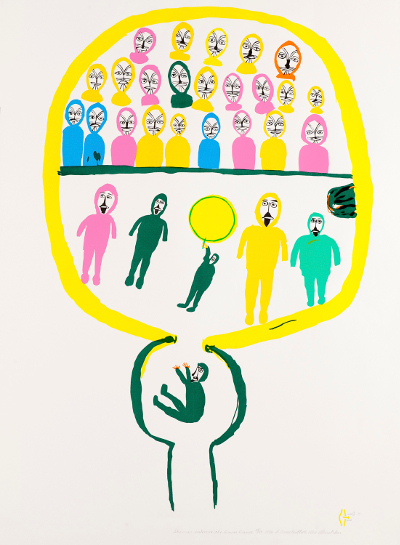
Shaman Entering the Drum Dance
Shaman Entering the Drum Dance
Luke Anguhadluq, 1976
Silkscreen on paper
30 x 22 in. (76 cm. x 56 cm.)
Robert and Judith Toll Collection, 2009.7.141
During a shamanic ceremony, the people gather in a qalgiq (gathering house), with men sitting in the front and women sitting behind. Led by a Shaman, this ceremony is a very spiritual, even out of body, experience. A drum, the key instrument, is used to control the pace of the situation. As the only musical instrument employed by the Inuit, the drum plays a crucial role in various spectacles, including drum dance competitions and athletic activities such as the "finger pull."
(M. Brown)
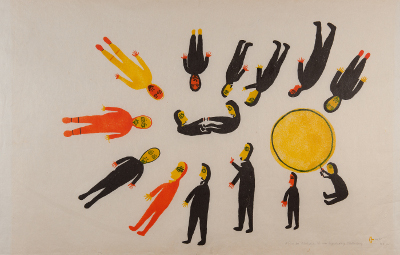
A Time for Celebration
A Time for Celebration
Luke Anguhadluq, 1974
Stonecut and stencil on paper
25 x 39 in. (64 cm. x 99 cm.)
Robert and Judith Toll Collection 30, 2009.7.140
This drawing depicts the finger pull, a traditional game that is still played today. It consists of two youths interlocking fingers and pulling in opposite directions until one opponent loses his grip and his fingers slip, thus becoming the loser. This athletic activity enhances one’s endurance and grit, two qualities that are critical to climbing and overall survival. Celebratory singing, dancing, and drumming often occur simultaneously alongside these games, represented and emphasized here by the enlarged drum. The circle of spectators surrounding the two participants illustrates how these competitions connect individuals to their shared identity and community.
(B. Wrubel)
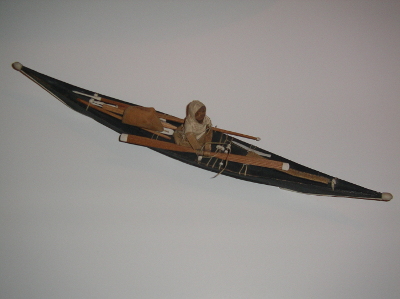
Model Kayak with Wooden Figure, Tools, and Harpoons tipped with Ivory
Model Kayak with Wooden Figure, Tools, and Harpoons tipped with Ivory
Unidentified Inuk Artist, ca. 20th century
Skin on wood
14 3/4 x 2 in. (37 cm. x 5 cm.)
Gift of Miriam MacMillan, 1974.1.11.1f
The kayak is one of the most iconic objects associated with the Inuit to outsiders, as indicated by its many reproduction in photography or as souvenirs in the form of miniature models. Kayaks are an integral part of the Inuit daily life for subsistence hunting of seals and other marine mammals. One performative and community-building way of kayak training for boys and young men is to organize public competitions in front of the community to test who can paddle the fastest, roll the smoothest, and throw most accurately from a kayak. These competitions, particularly capsizing and rolling—a crucial survival technique, fascinated Europeans since their first encounters in the 17th century and evolved into a popular performative spectacle to non-Inuit. Today, kayak competitions still occur regularly in Greenland, a source of national pride that ensures the traditions and heritage of the Inuit persist in modernity.
(B. Wu)
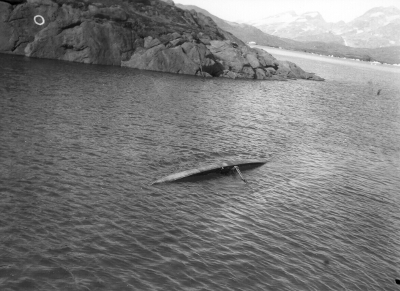
Rolling a Kayak
Rolling a Kayak
Reginald Wilcox
Negative
3000.10.235
The kayak is one of the most iconic objects associated with the Inuit to outsiders, as indicated by its many reproduction in photography or as souvenirs in the form of miniature models. Kayaks are an integral part of the Inuit daily life for subsistence hunting of seals and other marine mammals. One performative and community-building way of kayak training for boys and young men is to organize public competitions in front of the community to test who can paddle the fastest, roll the smoothest, and throw most accurately from a kayak. These competitions, particularly capsizing and rolling—a crucial survival technique, fascinated Europeans since their first encounters in the 17th century and evolved into a popular performative spectacle to non-Inuit. Today, kayak competitions still occur regularly in Greenland, a source of national pride that ensures the traditions and heritage of the Inuit persist in modernity.
(B. Wu)
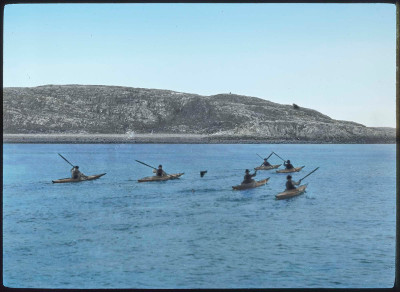
Kayaks Returning to Cobb Harbor
Kayaks Returning to Cobb Harbor
Donald B. MacMillan
Hand Tinted Lantern Slide
4 x 3 1/4 x 1/4 in. (10 cm. x 8 cm. x 1 cm.)
Gift of Donald and Miriam MacMillan, 3000.32.1760
The kayak is one of the most iconic objects associated with the Inuit to outsiders, as indicated by its many reproduction in photography or as souvenirs in the form of miniature models. Kayaks are an integral part of the Inuit daily life for subsistence hunting of seals and other marine mammals. One performative and community-building way of kayak training for boys and young men is to organize public competitions in front of the community to test who can paddle the fastest, roll the smoothest, and throw most accurately from a kayak. These competitions, particularly capsizing and rolling—a crucial survival technique, fascinated Europeans since their first encounters in the 17th century and evolved into a popular performative spectacle to non-Inuit. Today, kayak competitions still occur regularly in Greenland, a source of national pride that ensures the traditions and heritage of the Inuit persist in modernity.
(B. Wu)

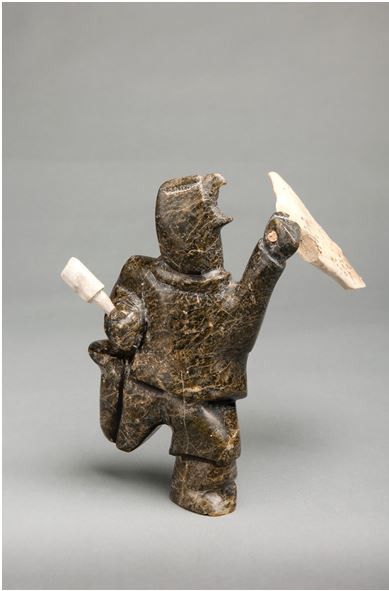
Bird Transformation
Bird Transformation
Unidentified Inuk Artist
Soapstone
7 7/8 x 5 7/8 x 1 15/16 in. (20 cm. x 15 cm. x 5 cm.)
Harry Z. and Ruth L. Sky Collection, 2010.8.3
The Inuktitut word for drum is qilaut, which according to anthropologist Knud Rasmussen means “that by means of which the spirits are called up.” Shamans, often shown in states of transformation, use drums to call up their helping spirits. The Bird Woman Drummer and Fox/Wolf Drummer are involved in this serious activity.
(Museum)
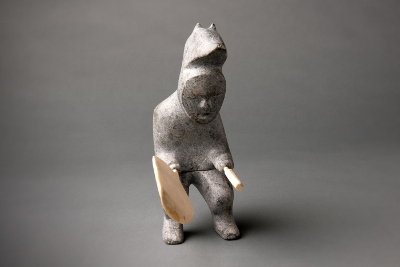
Fox/Wolf Drummer
Fox/Wolf Drummer
Nicholas Kringayark, 1982
Stone with antler
9 x 3 x 6 1/2 in. (23 cm. x 8 cm. x 17 cm.)
Robert and Judith Toll Collection, 2009.7.74
The Inuktitut word for drum is qilaut, which according to anthropologist Knud Rasmussen means “that by means of which the spirits are called up.” Shamans, often shown in states of transformation, use drums to call up their helping spirits. The Bird Woman Drummer and Fox/Wolf Drummer are involved in this serious activity.
(Museum)


